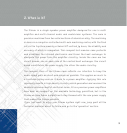
4
3. How does the Klimax work?
In most power amplifiers the power supply comprises a large transformer, a
rectifier and reservoir capacitors, often as large as the transformer. The
highest performance amplifiers also have voltage regulators which maintain
the power supplied to the amplifier circuitry constant, regardless of the
input voltage or the output load. The bulk of these components dominates
the size of the amplifier and the ‘tightness’ of the audio path, and if voltage
regulators are present the power dissipation of the amplifier increases by
up to 50%, requiring a bigger heat exchanger. This conventional type of power
supply is simple, reliable, tolerant of overload and predictable. On the down
side it is very bulky, heavy, slow to respond, inefficient, causes high mains
power distortion, can cause electrical and acoustic noise and requires a
relatively long and exposed audio path.
In the Klimax we use a technology we have been developing and using in our
low power products for several years, called ‘switch mode’. This concept is
not new; it has been used in computers since the 1960’s, however applying it
to audio has always been considered, at best, inappropriate. The potential
benefits of switch mode power supply technology are compactness, high
efficiency, fast response, good mains input tolerance, good load tolerance,
low acoustic noise and with its low material use, environmental friendliness.
The potential downsides are electrical noise, high complexity and potentially
lower reliability, complex certification requirements, design difficulty and high
engineering cost. These have kept switch mode out of most audio equipment.


















